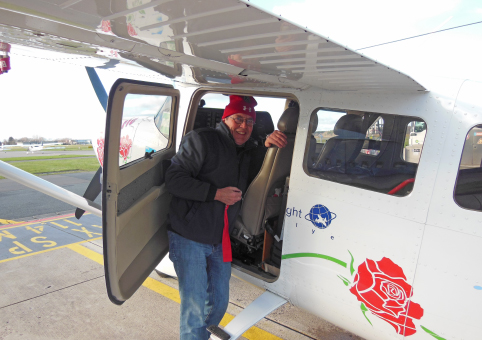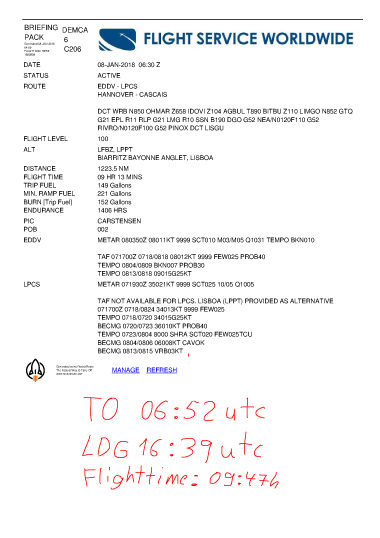Flight Log: Hannover EDDV -- Cascais LPCS 08.01.2018/09.01.2018
 Loading. Please wait...
Loading. Please wait...
Finished packing



Finished packing

Kurt’s delighted

Marie tested

From nighttime into the sun

Kurt’s mood is improving

Captain at work

Route to Biarritz in sight

View of the Alps

Pyrenees in sight

En-route paperwork

Another one

Snow in the Basque region

Approach to Cascais. Into a sea of houses

Final VOR 35 approach

A lovely person to receive us

Kurt thinks so too

Exhaustion makes itself plain


 8 January 2018, Hanover — Cascais:
We enjoyed taking a fond farewell in the dark in Hanover with a few dear friends, family and from Marie and Aniko of course, was well as our point of contact at DEMCA Mr Müller. We then ambled over the airport in the dark. With the aid of our display, we were in fact able to find the taxiway to the 09 on the left and prepare the aircraft for take-off.
Kurt was slightly nervous because it was the first time he’d taken off during such a dark night, but confidence in Marie's instruments was boosted after we did have some visibility a quarter of an hour later when dawn was breaking. We were even able to see Hanover a little. After about 20 minutes, we could see the sun on the horizon once we’d reached 10,000 feet. We were then at cruising altitude and of course had to go through the checklist to ensure the flight went smoothly. We started with fuel management, in other words noting which tank the aviation fuel is taken from and pumped into the wing tanks to ensure that we never ran out of fuel. After an hour, we could already see the route to Biarritz on the display. We had tailwind of about 15 knots, so we got on well at ground speed of between 135 and 145 knots. That’s pretty good! But our joy didn’t last for long because at some point we couldn’t see anything any more. We were flying in cloud and also had a bit of ice forming, which of course our de-icing equipment had to get rid of. But it was great once we came out of the cloud and saw the Alps on the left. Kurt told me what type of Alps these should be in his opinion. We repeatedly looked at the aviation fuel levels and made sure that our plane always had enough fuel.
Things changed slightly with the tailwind: once we got close to the Pyrenees, we had side wind of 45 knots. The plane had to fly slightly askew and then we had headwind of 10 knots due to the Pyrenees so we had to fly a little more slowly than we would have liked. As you can see on the pictures, we spent the whole time working – just like people at their desks. That’s the thing with pilots who only fly on Sundays and still write down their radio messages. But everybody has their own style. The iPad really helped us the whole time, giving us meteorological information, the flight path and information on each of the airfields that might be alternatives to the actual airfield we were heading for. Once we had passed Biarritz and flown into the Basque region, we were still able to marvel at the Pyrenees, in particular the mountains with snow. And by the way, there was still quite a lot of snow in the Basque region. However, once we were over the Basque region, radio communications became much more difficult. Not because you couldn’t hear people because they weren’t loud enough, but because the Spanish people’s English was hard to understand and meant we had to ask a lot of questions or get them to spell something so that we stayed on the right course. Over Spain, we then had to ascend to 11,000 feet because that was apparently the minimum safety altitude. But we carried out instructions as advised. At the border to Portugal, when we’d already been flying for five and a half hours, the Portuguese controllers came on the scene. They spoke very good English and it was easy to understand their instructions so that we were able to see the relevant destinations we were to fly to and waypoints on the aeronautical charts and iPad. That was not always the case with the Spanish controllers. We were instructed to take the VOR approach 35 (350 degrees) in Cascais in order to land. In other words, we had to circle to land, or fly past the airfield and turn 180° in order to head for the 17 (170 degree landing direction) and land.
In wonderful weather and without very strong wind, we had good visibility over the whole town. We landed, were directed to our parking position and our very pretty handling agent was already awaiting us. First of all, she organised a tank truck and a taxi and showed us old guys where the WC was. After all, nature was definitely calling after 9 hours and 46 minutes! Once we’d filled the plane up we were exhausted – as you can see on the pictures. We took the taxi to the hotel and the day drew to a close.
8 January 2018, Hanover — Cascais:
We enjoyed taking a fond farewell in the dark in Hanover with a few dear friends, family and from Marie and Aniko of course, was well as our point of contact at DEMCA Mr Müller. We then ambled over the airport in the dark. With the aid of our display, we were in fact able to find the taxiway to the 09 on the left and prepare the aircraft for take-off.
Kurt was slightly nervous because it was the first time he’d taken off during such a dark night, but confidence in Marie's instruments was boosted after we did have some visibility a quarter of an hour later when dawn was breaking. We were even able to see Hanover a little. After about 20 minutes, we could see the sun on the horizon once we’d reached 10,000 feet. We were then at cruising altitude and of course had to go through the checklist to ensure the flight went smoothly. We started with fuel management, in other words noting which tank the aviation fuel is taken from and pumped into the wing tanks to ensure that we never ran out of fuel. After an hour, we could already see the route to Biarritz on the display. We had tailwind of about 15 knots, so we got on well at ground speed of between 135 and 145 knots. That’s pretty good! But our joy didn’t last for long because at some point we couldn’t see anything any more. We were flying in cloud and also had a bit of ice forming, which of course our de-icing equipment had to get rid of. But it was great once we came out of the cloud and saw the Alps on the left. Kurt told me what type of Alps these should be in his opinion. We repeatedly looked at the aviation fuel levels and made sure that our plane always had enough fuel.
Things changed slightly with the tailwind: once we got close to the Pyrenees, we had side wind of 45 knots. The plane had to fly slightly askew and then we had headwind of 10 knots due to the Pyrenees so we had to fly a little more slowly than we would have liked. As you can see on the pictures, we spent the whole time working – just like people at their desks. That’s the thing with pilots who only fly on Sundays and still write down their radio messages. But everybody has their own style. The iPad really helped us the whole time, giving us meteorological information, the flight path and information on each of the airfields that might be alternatives to the actual airfield we were heading for. Once we had passed Biarritz and flown into the Basque region, we were still able to marvel at the Pyrenees, in particular the mountains with snow. And by the way, there was still quite a lot of snow in the Basque region. However, once we were over the Basque region, radio communications became much more difficult. Not because you couldn’t hear people because they weren’t loud enough, but because the Spanish people’s English was hard to understand and meant we had to ask a lot of questions or get them to spell something so that we stayed on the right course. Over Spain, we then had to ascend to 11,000 feet because that was apparently the minimum safety altitude. But we carried out instructions as advised. At the border to Portugal, when we’d already been flying for five and a half hours, the Portuguese controllers came on the scene. They spoke very good English and it was easy to understand their instructions so that we were able to see the relevant destinations we were to fly to and waypoints on the aeronautical charts and iPad. That was not always the case with the Spanish controllers. We were instructed to take the VOR approach 35 (350 degrees) in Cascais in order to land. In other words, we had to circle to land, or fly past the airfield and turn 180° in order to head for the 17 (170 degree landing direction) and land.
In wonderful weather and without very strong wind, we had good visibility over the whole town. We landed, were directed to our parking position and our very pretty handling agent was already awaiting us. First of all, she organised a tank truck and a taxi and showed us old guys where the WC was. After all, nature was definitely calling after 9 hours and 46 minutes! Once we’d filled the plane up we were exhausted – as you can see on the pictures. We took the taxi to the hotel and the day drew to a close.